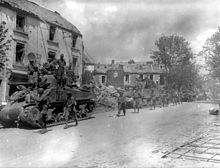Operation Cobra
| Operation Cobra | |||||||
|---|---|---|---|---|---|---|---|
| Part of Operation Overlord (the Battle of Normandy) | |||||||
 M4 and M4A3 Sherman tanks and infantrymen of the US 4th Armored Division in Coutances |
|||||||
|
|||||||
| Belligerents | |||||||
|
|
|
||||||
| Commanders and leaders | |||||||
|
|
|
||||||
| Strength | |||||||
| 8 infantry divisions 3 armored divisions 2,451 tanks and tank destroyers |
2 infantry divisions 1 parachute division 4 understrength Panzer divisions 1 Panzergrenadier division 190 tanks and assault guns |
||||||
| Casualties and losses | |||||||
| 1,800 casualties at least 109 medium tanks unknown number of light tanks and tank destroyers |
~ 70 tanks and assault guns | ||||||
Operation Cobra was the codename for an offensive launched by the First United States Army (Lieutenant General Omar Bradley) seven weeks after the D-Day landings, during the Normandy Campaign of World War II. The intention was to take advantage of the distraction of the Germans by the British and Canadian attacks around Caen, in Operation Goodwood and break through the German defenses that were penning in his troops, while the Germans were unbalanced. Once a corridor had been created, the First Army would then be able to advance into Brittany, rolling up the German flanks once free of the constraints of the bocage country. After a slow start the offensive gathered momentum and German resistance collapsed as scattered remnants of broken units fought to escape to the Seine. Lacking the resources to cope with the situation, the German response was ineffectual and the entire Normandy front soon collapsed. Operation Cobra, together with concurrent offensives by the British Second Army and the Canadian First Army, was decisive in securing an Allied victory in the Normandy Campaign.
Having been delayed several times by poor weather, Operation Cobra commenced on 25 July, with a concentrated aerial bombardment from thousands of Allied aircraft. Supporting offensives had drawn the bulk of German armored reserves toward the British and Canadian sector and coupled with the general lack of men and materiel available to the Germans, it was impossible for them to form successive lines of defense. Units of the U. S. VII Corps led the initial two-division assault, while other First Army corps mounted supporting attacks designed to pin German units in place. Progress was slow on the first day but opposition started to crumble once the defensive crust had been broken. By 27 July, most organized resistance had been overcome and the VII and VIII Corps advanced rapidly, isolating the Cotentin peninsula.
...
Wikipedia
